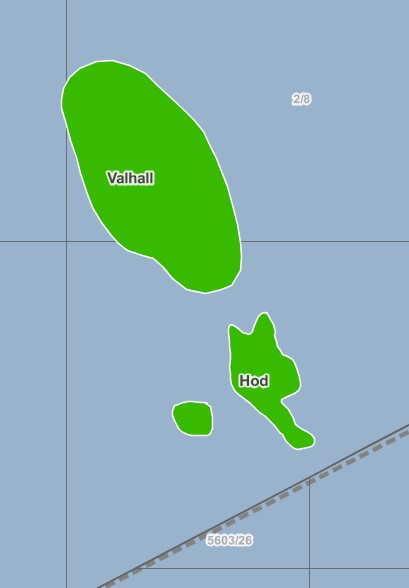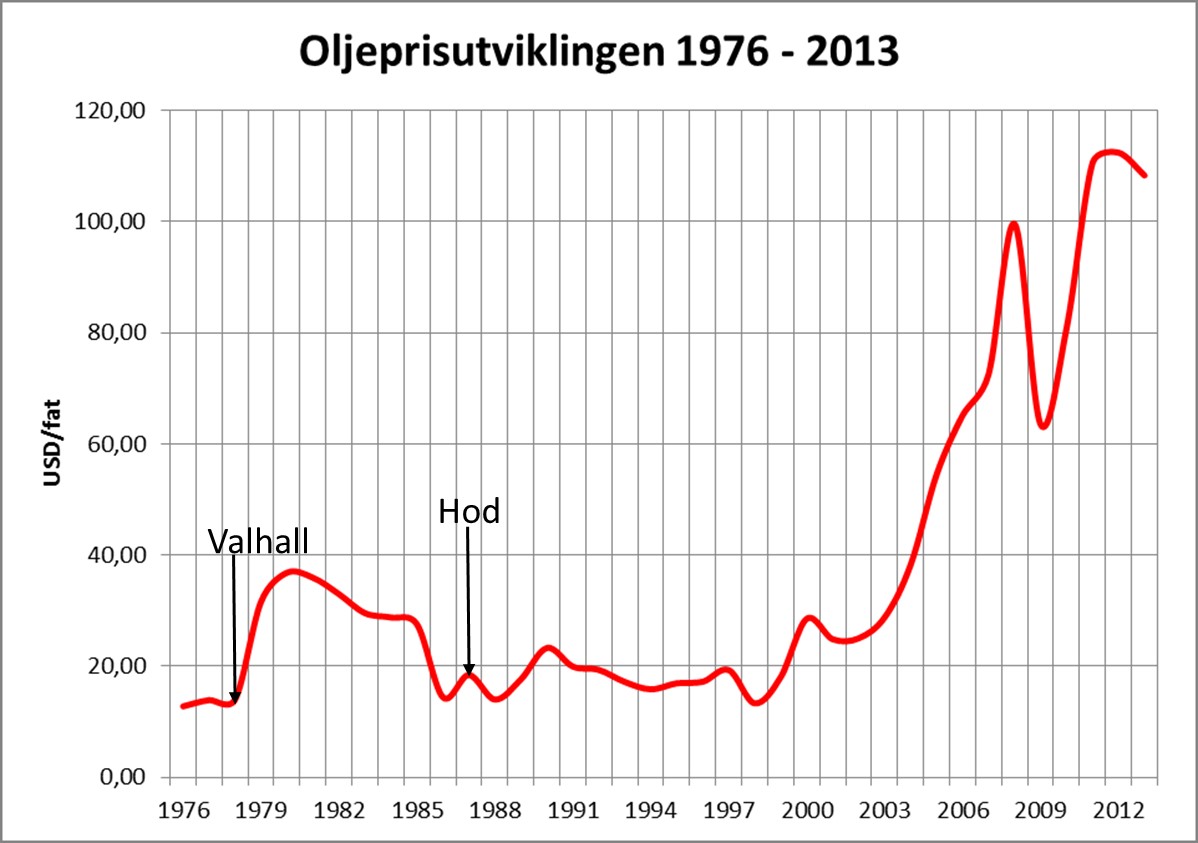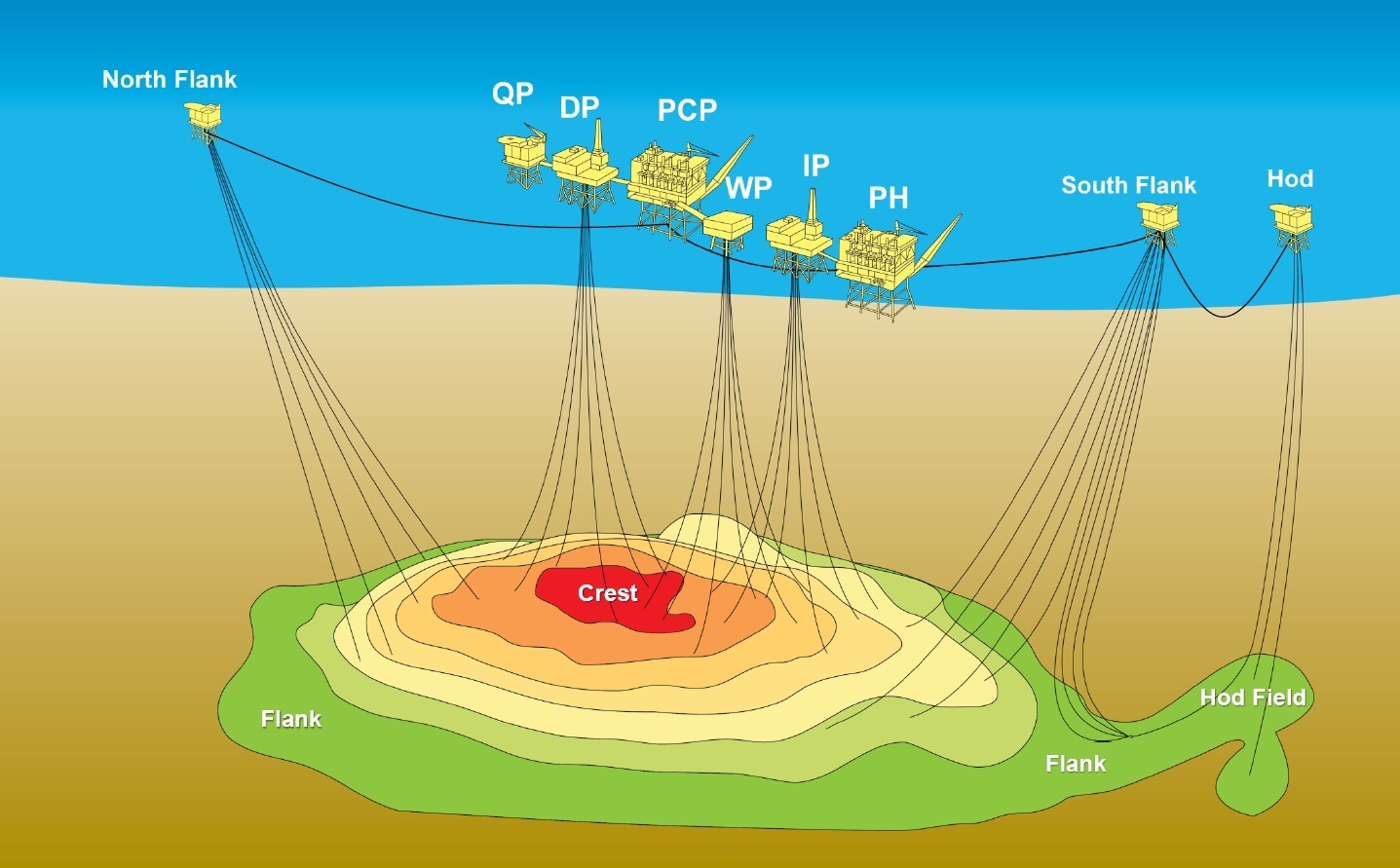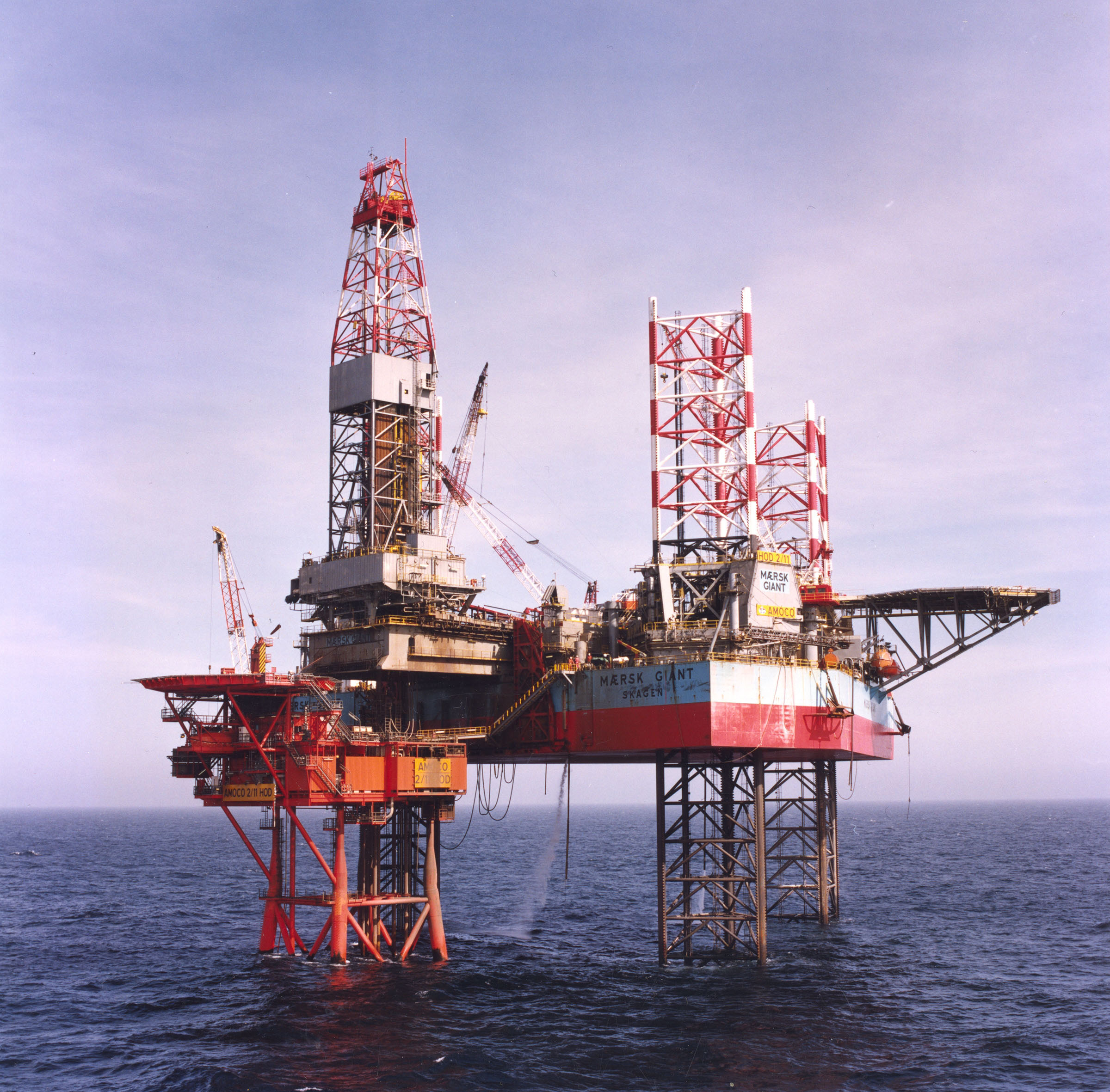From discovery to development with Hod

The same oil companies were licensees for both Hod and Valhall, with Amoco as operator and Amerada, Texas Eastern and Noco as partners. Each of these licensees had a 25 per cent interest. But development of Hod could not begin until the main Valhall field was on stream.
 Fra funn til utbygging av Hod,
Fra funn til utbygging av Hod,Once work on Valhall had got well under way in 1977, further appraisal of Hod was initiated. Well 2/11-3 on the eastern flank of the discovery was spudded in October from jack-up Dyvi Beta .
The discovery that carbonate rock lay at a deeper level than anticipated, and that it was primarily an aquifer, confirmed West and East Hod as separate structures or domes.
To determine whether oil existed in East Hod, drilling was deviated at an angle of 45 degrees to hit this structure centrally. That proved 40 metres of petroleum-bearing chalk, but more wells were needed before the discovery could be declared commercial.[REMOVE]Fotnote: Noco, annual report and accounts, 31 December 1977, 4–5.
A total of five wells were drilled on Hod in 1982, with oil and gas proven in two separate zones in Upper Cretaceous rocks. In connection with this work, a template was installed between the two structures so that the well drilled through it could be used for production if the discovery was brought on stream.
The reservoirs were estimated to contain 6.5 million cubic metres (41 million barrels) of oil and 3.5 billion cubic metres of gas.[REMOVE]Fotnote: Noco, annual report 1981, 15. These figures were later reduced.
Amoco now assessed various development concepts. The best options were either a subsea installation – untested off Norway at the time – or a simple production platform tied back to the Valhall processing facilities. It was unclear when a possible plan for development and operation (PDO) would be submitted.[REMOVE]Fotnote: Noco, annual report 1982, 6.
Valhall came on stream in 1982, but it soon transpired that production from the wells was not straightforward. (See the article on the troublesome opening of the Valhall field.) The chalk reservoir presented big challenges.
This probably helped to reduce interest in an early development of Hod. With the Valhall production wells needing to be licked into shape first, the Hod project entered a wait-and-see phase.
Noco’s annual report for 1985 stated: “Amoco was still working on plans aimed at a possible development solution for Hod, which provides a reasonable rate of return in relation to the risks involved in the project”.[REMOVE]Fotnote: Noco, annual report 1985, 5.
Oil price rise and fall
The first half of the 1980s was a good time for the oil companies, with crude prices at USD 35–40 per barrel. This meant that the huge investments made on fields such as Valhall, Ekofisk, Frigg, Odin and Statfjord were rapidly repaid. A large part of the capital spending was also depreciated for tax purposes.
This meant that the cost of maintaining production mainly represented operation, maintenance and pay. A field like Ekofisk could cope with an oil price as low as USD 3–4 per barrel to cover its costs, while others needed just under USD 30 per barrel to be profitable.
These calculations derive from a study conducted by the Ministry of Petroleum and Energy in the autumn of 1985 to see how low a price the oil companies on the Norwegian continental shelf (NCS) could handle.
Should crude oil prices fall much below USD 20 per barrel, developing new fields off Norway was unlikely to be profitable. Oil operations beyond the North Sea, in the Norwegian and Barents Seas, would be particularly hard hit.
Norway would experience a dramatic decline in oil revenues – for each USD 1 fall in crude prices, annual tax revenues from the oil sector would sink by NOK 2 billion. And should prices drop as low as USD 10 per barrel, these earnings would fall to zero.
The same would be the case for oil company profits, leading in turn to a complete shutdown of all exploration activity on the NCS.[REMOVE]Fotnote: Aftenposten , 20 December 1985, “Oljefelt tåler sterkt prisfall”.
 Fra funn til utbygging av Hod,
Fra funn til utbygging av Hod,Precisely what the government had feared occurred in 1986. Oil prices slumped from USD 35 to USD 10 per barrel as a result of overproduction on a global basis.
High per-barrel prices had tempted the producer countries to open the taps, and the Organisation of Petroleum Exporting Countries (Opec) was not strong enough to impose moderation on its members.
Saudi Arabia, which had earlier been willing to reduce its output in order to keep prices stable, also felt it would now be served by letting them fall.
Among other perceived benefits, that would hit the Soviet Union’s economy because oil accounted for about 85 per cent of its export revenues.
The Soviet invasion of Afghanistan had aroused Saudi opposition, and the advantages of hurting the USSR were also perceived by the USA under president Ronald Reagan. Moreover, cheaper oil would boost American economic performance.
So the price collapse of 1986 was not necessarily a chance and incomprehensible event, but partly the outcome of a political process.
Adapting to an oil price of USD 10 per barrel proved painful, not least for Norway with its relatively high level of offshore costs.
Crisis promotes creativity
 Fra funn til utbygging av Hod,
Fra funn til utbygging av Hod,It did not take long for the price slump to affect Hod, with Norwegian wire service NTB reporting on 18 February 1986: “The Hod oil and gas field, closest neighbour to Valhall south of Ekofisk, will not be developed at today’s low oil prices. The Hod partners – operator Amoco, Amerada, Texas Eastern and Noco – have resolved to put their development plans on ice.”[REMOVE]Fotnote: NTB, 18 February 1986, “Oljeprisfallet gjør feltet ulønnsomt”.
“Nor will we be spudding a new appraisal well in the Hod area, which was under consideration last year,” said legal officer Tore Ulleberg in Amoco.
The only development which could have persuaded the licensees to revive these plans would be radical changes to Norway’s offshore tax regime.
The small size of Hod’s reserves meant it was always seen as a typical marginal field, on the edge of profitability. Studies showed that a low oil price undermined arguments for developing it.[REMOVE]Fotnote: NTB, 18 February 1986, “Oljeprisfallet gjør feltet ulønnsomt”.
In general terms, the price slump can be said to have inspired new ways of thinking in the oil industry. The necessity of reducing costs gave a boost to innovative technical solutions.
A case in point is subsea installations, which experienced their breakthrough after 1986 and meant that discoveries could be developed as satellites to existing fields.[REMOVE]Fotnote: Ole Andreas Engen and Odd Einar Olsen in Oljevirksomheten som teknologiutviklingsprosjekt (1997), 156-166.
The Norwegian Petroleum Directorate (NPD) was presented with a feasibility study for Hod in 1987 which involved a simple solution based on seabed facilities. A subsea template was already in place on the field, with one well drilled through it.[REMOVE]Fotnote: NTB, 30 September 1987, “Amoco vurderer mulig Hod-utbygging”. But the engineers did not regard subsea technology as the only possible option. With support from partners Amerada Hess, Texas Eastern and Noco, Amoco submitted a new development plan to the government for approval in March 1988 which built on the idea of a remotely operated unstaffed production platform.[REMOVE]Fotnote: NTB, 4 February 1988, “Amoco går inn for å bygge ut Hod-feltet”.
Hod was a relatively small field with a favourable water depth of about 70 metres. That permitted a simple steel structure in place of a subsea solution. This innovative thinking made a previously marginal discovery financially interesting. The plan was approved by petroleum and energy minister Arne Øien in June 1988. Hod would rank as the cheapest field developed until then on the NCS.
In the ministry’s view, the approach adopted was tailored to the prevailing oil price uncertainty and could provide a precedent for new cost-effective development solutions on small NCS fields.[REMOVE]Fotnote: NTB, 17 June 1988, “OED går inn for rekordbillig Hod-utbygging nær Ekofisk”.
The plan, costed at NOK 630 million in 1988 value, called for a small unstaffed and fully automated steel platform of 4 100 tonnes to be placed on Hod. A jack-up would drill four-five wells.
Being able to get the price so far down was partly a result of eliminating processing, drilling and quarters facilities on the installation.
“The platform will have nobody on board for five days of the week, while maintenance personnel will make two weekly inspections,” reported project director Asbjørn Tansø in Amoco.
Production would be remotely operated from Valhall, 13 kilometres away, where the oil would also be processed. Hod production and operations at the Tananger base would be handled without additional staffing.[REMOVE]Fotnote: NTB, 17 June 1988, “OED går inn for rekordbillig Hod-utbygging nær Ekofisk”. With start-up scheduled for 1990, the field was expected to produce for 15 years.
Both the petroleum ministry and the NPD were pleased with the development concept for Hod, which was both simple and cheap, and presented little safety risk.[REMOVE]Fotnote: NTB, 17 June 1988, “OED går inn for rekordbillig Hod-utbygging nær Ekofisk”.
 Fra funn til utbygging av Hod,
Fra funn til utbygging av Hod,The offshore unions were also positive to the project. Hod would, after all, provide some employment. The platform would get weekly inspection and maintenance, and have overnight accommodation for 10 people in the event of fog or bad weather.
Moreover, the Hod development would provide work for crew on the rigs required to drill the production wells, which would take almost a year.[REMOVE]Fotnote: Aftenposten, 20 July 1988, ”I drift på Hodfeltet om to år: Fjernstyrt plattform”.
Both government and unions accepted the innovative technological solution in order to get Hod on stream and make it profitable.
Read more in the article on Development of Hod.
Amoco etablerer seg i StavangerDiscovery of Hod and Valhall